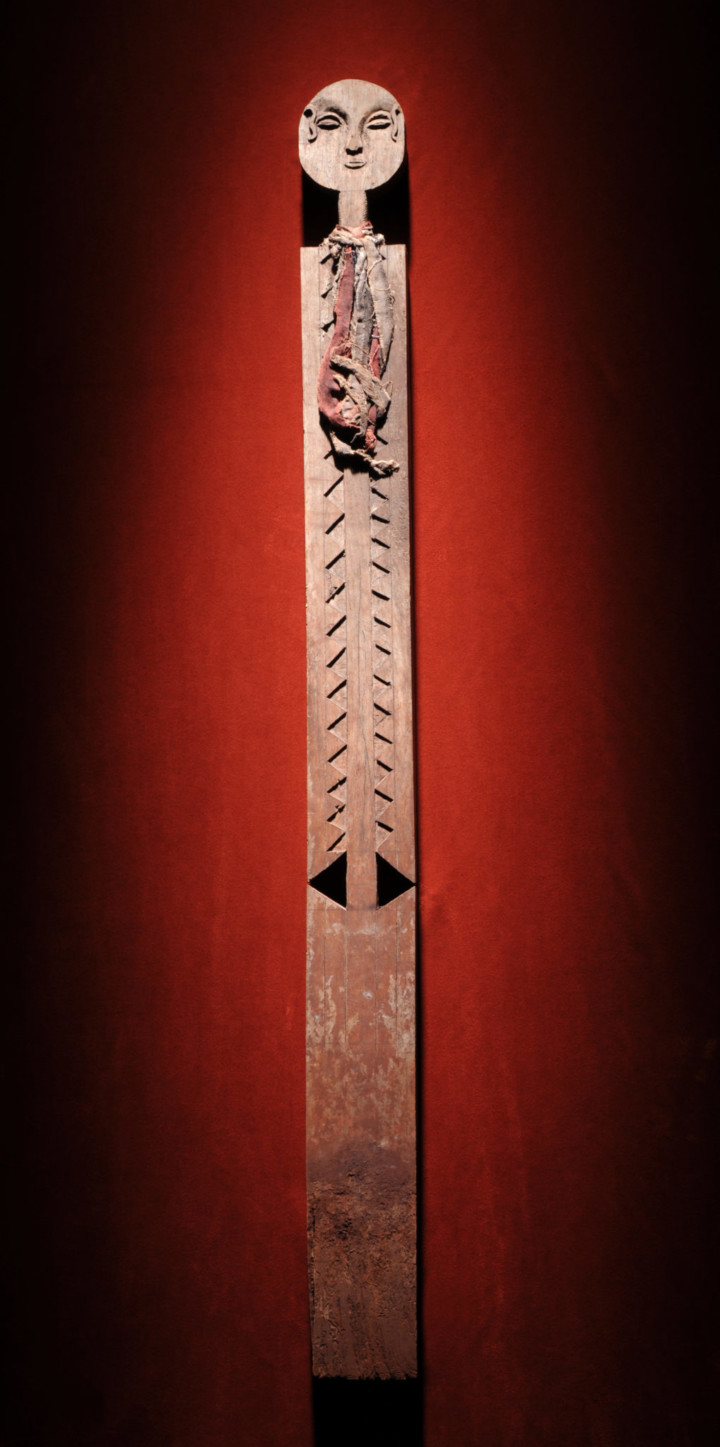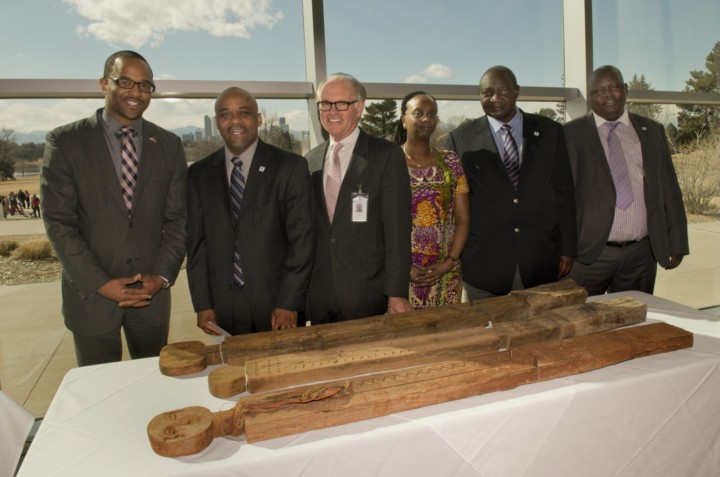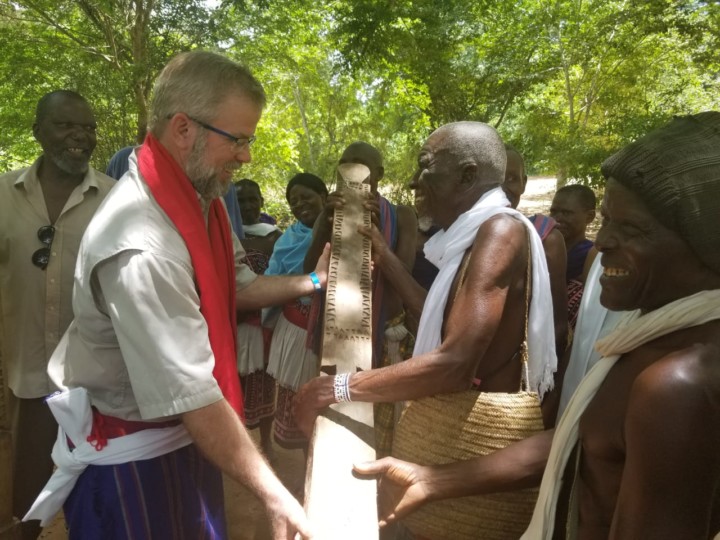Written by Chip Colwell and Stephen E. Nash
Pillaging, taking without asking, manifest destiny—stolen ancestors. These are all terms and actions that modern-day society must contend with on the path to reparation, toward righting harmful wrongs. To look honestly at our collective actions, as a nation, community, or even a state museum, is a necessary step in recovery from the harmful impacts of history. Often, inanimate things have meaning, to families, peoples, cultures, and countries. Here is the complicated journey home and repatriation of the vigango, the memorial statues of the Mijikenda peoples of Kenya.
Stolen Statues: From Sacred Memorials to Tax Deductions
The memorial posts seemed so permanent, a part of the sacred landscape like the ancient trees that surrounded them. They were carved from hard termite-resistant wood, shaped in an abstract human form. Erected to honor the venerated ancestors of a secret society, they are believed to embody the dead person’s soul. The memorial statutes protected the Mijikenda people and kept harm at bay. Who would think to steal them?
Starting in the 1980s, an art dealer in California did. He started to pay young, unemployed youth in Kenya to steal the vigango (singular: kikango): vigango are memorial statues some Kenyans believe are endowed with divine powers
Once they left East Africa, the memorial statues entered a legal limbo: at the time, it was not illegal to export vigango from Kenya, and in the U.S. it was not illegal to import them. The art dealer sold them to Hollywood elites and then arranged for them to be donated to small, unaware museums. In turn, the dealer’s clients would get a hefty tax break through the donations.
Through his actions, this art dealer transformed hundreds of vigango from sacred, living memorials into ethnographic curiosities and tax deductions.
The Repatriation of Ancestral Remains
Several years ago Chip Colwell, a curator at the Denver Museum of Nature and Science (DMNS), presented a talk at TEDxMileHigh on the removal and return of Native American ancestral remains and sacred objects. The United States has been a major focus of the repatriation battles—as hundreds of tribes have sought to reclaim tens of thousands of cultural items from museums. However, these issues go far beyond the United States.
In the case of artifacts, repatriation is the return of an item of symbolic value to its place of origin.
The work of repatriation has been needed because over the last several centuries museums have gathered the belongings of Native Americans. Most of these were collected through fair methods and honor Indigenous peoples. But, some objects were taken without the consent of communities. Sometimes objects were simply stolen.
Vigango: The Process of Repatriation
In 2008, Colwell attended a lecture by his anthropologist colleagues Monica Udvardy and Linda Giles about vigango and their sordid history in the United States. He realized that the DMNS, where he had just started work, curated 30 of the memorials.
By extension, and according to Mijikenda beliefs, we were, therefore, curating 30 dead souls.
After consulting with Steve Nash, Director of Anthropology and Senior Curator of Archaeology at the Denver Museum, as well as the museum’s senior leadership and trustees, the museum resolved to enter into consultations with Kenyan authorities.
We anticipated a quick resolution. The vigango were stolen. The museum did not want to possess stolen property.
But, we did not have contacts with the Mijikenda and many Kenyan authorities were unsure of how to proceed. Finally, we realized that one of Denver’s sister cities is Nairobi. Colwell called up his local councilman, Albus Brooks, who arranged a meeting with the head of Kenya’s parliament at the time. An agreement was struck.
Divine Powers Meet Red Tape
In January 2014, we held a return ceremony in Denver. It was attended by Mayor Michael B. Hancock and Kenya’s ambassador to the United States. The ceremony was covered by The New York Times. We agreed to return the 30 vigango to the National Museums of Kenya, which in turn, would do its best to ensure the memorials went to the appropriate Mijikenda communities.
After the handshakes, and the agreement was signed, the museum staff packed up the vigango and started the paperwork to send them to Kenya. It was then that we were told since the vigango were considered art pieces, they would be subject to a Kenyan import tariff of $40,000 USD. That figure was way too much for the museum.
And so the vigango sat. Until last year, when Nash met Dr. Purity Kiura of the National Museums of Kenya. With her help, we were able to get the Kenya Revenue Authority to waive their tariff requirements. The vigango were sent and safely arrived at the National Museum in Nairobi on July 3, 2019.
The Vigango Return to the Mijikenda
In October 2019, Nash and his family traveled to Kenya to meet with Kiura and other representatives of the National Museums of Kenya to celebrate the repatriation. He also met with government officials in Kilifi County on the Kenyan coast, northeast of Mombasa, where most Mijikenda still make their home. Finally, Nash and his family met with Mijikenda leaders and elders to participate in a welcoming ceremony and celebration.



After the welcoming ceremony, Nash attended one more formal meeting with Mijikenda elders at a sacred forest called Kaya Fungo, for centuries their home and now a UNESCO World Heritage Site due to its cultural and ecological significance. They sat on small wooden stools around the edges of a small clearing in the forest; each man spoke in turn. Dr. Jimbi Kitana of the National Museums of Kenya, who also happens to be Mijikenda, served as a translator.
As with any such gathering, personalities become apparent fairly quickly—some people appear naturally jovial and welcoming, others are not. Sitting to the right of Nash and Jimbi was a particularly stern man who did most of the talking for his group. Repatriations are serious business, and he seemed to lighten up as the meeting went on. On the way out of the sacred forest, Jimbi explained to Nash why the man was stern—thieves had taken no fewer than seven vigango from his homestead during the 1980s. How would you feel if seven of your stolen ancestors had just been returned? It might take a while for you to begin celebrating.
Vigango: Repatriated and Protected
The 30 vigango repatriated by DMNS will not go back to their original homesteads—it’s impossible to determine where they came from because their original carvers are long since dead. Instead, the National Museums of Kenya is working with the Mijikenda to find an appropriate location for the vigango, hopefully in a new center in one of the sacred forests, where they can be protected. When the time comes, Mijikenda elders will plan and perform a cleansing ceremony for the vigango and all the celebrants, so that the souls of the ancestors can once again rest peacefully.
Repatriation Requires Effort and Patience
The hard work of repatriation takes patience, effort, empathy, and resources; not all of these are in abundant supply at cash-strapped museums in this country, not to mention around the world. Repatriation is not all about celebration either—religious leaders may have to create new rituals and ceremonies in order to welcome their material culture, and in some cases their ancestors, back into their living cultures. A half-century ago, many museums feared that repatriation would empty their storerooms.
Now we know the opposite—repatriation has forced museums to engage in collaborative, reciprocal efforts that enrich everyone while trying to ensure the greatest good for all.
The next time you are in a museum, search labels to see where objects came from. Reflect on how objects often have lives that precede the museum and ask whether their might serve a purpose outside the museum. And if you’re a collector, ensure that the objects in your collection have been ethically and legally obtained. For more on the repatriation battle, read Plundered Skulls and Stolen Spirits: Inside the Fight to Reclaim Native America’s Culture.


















